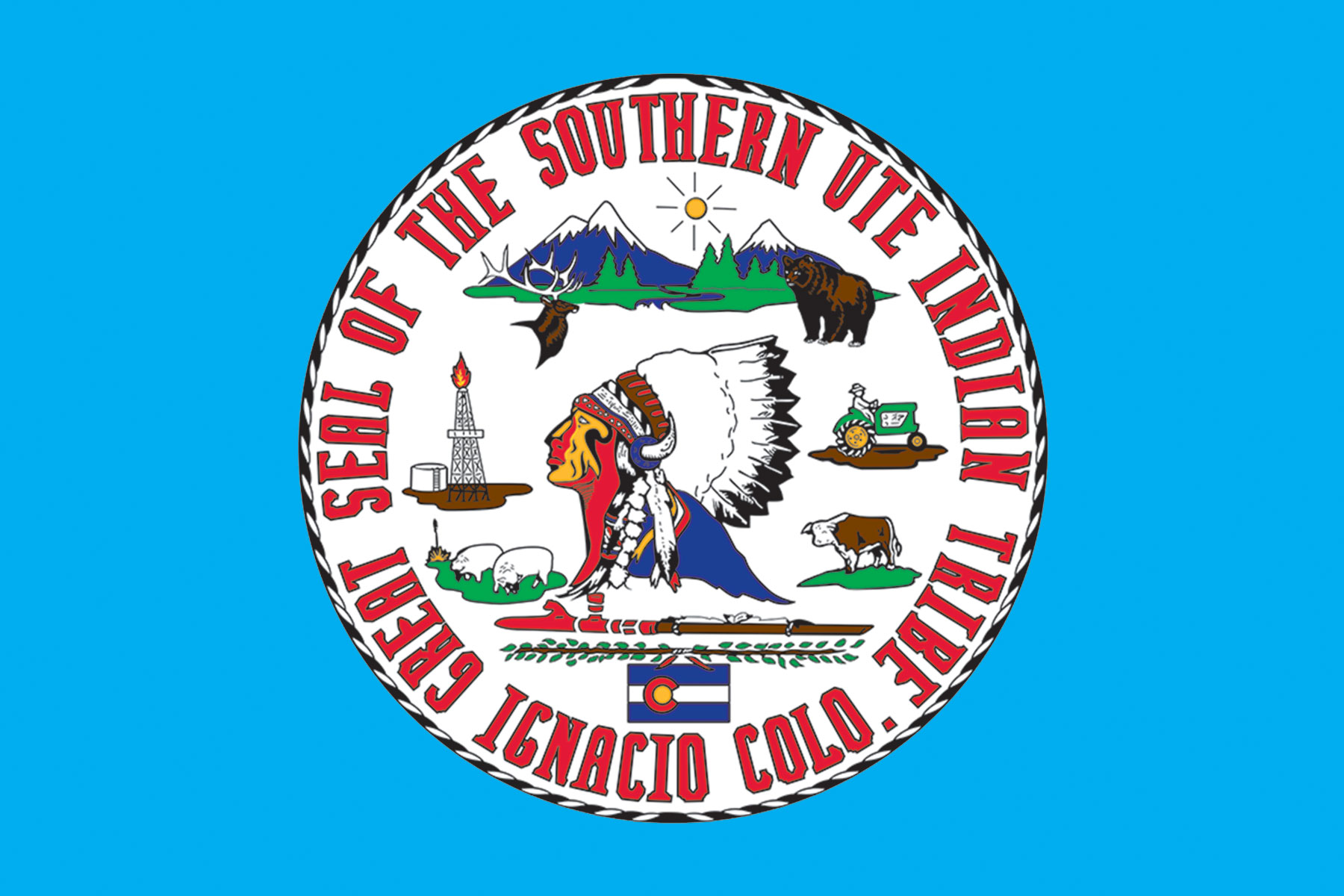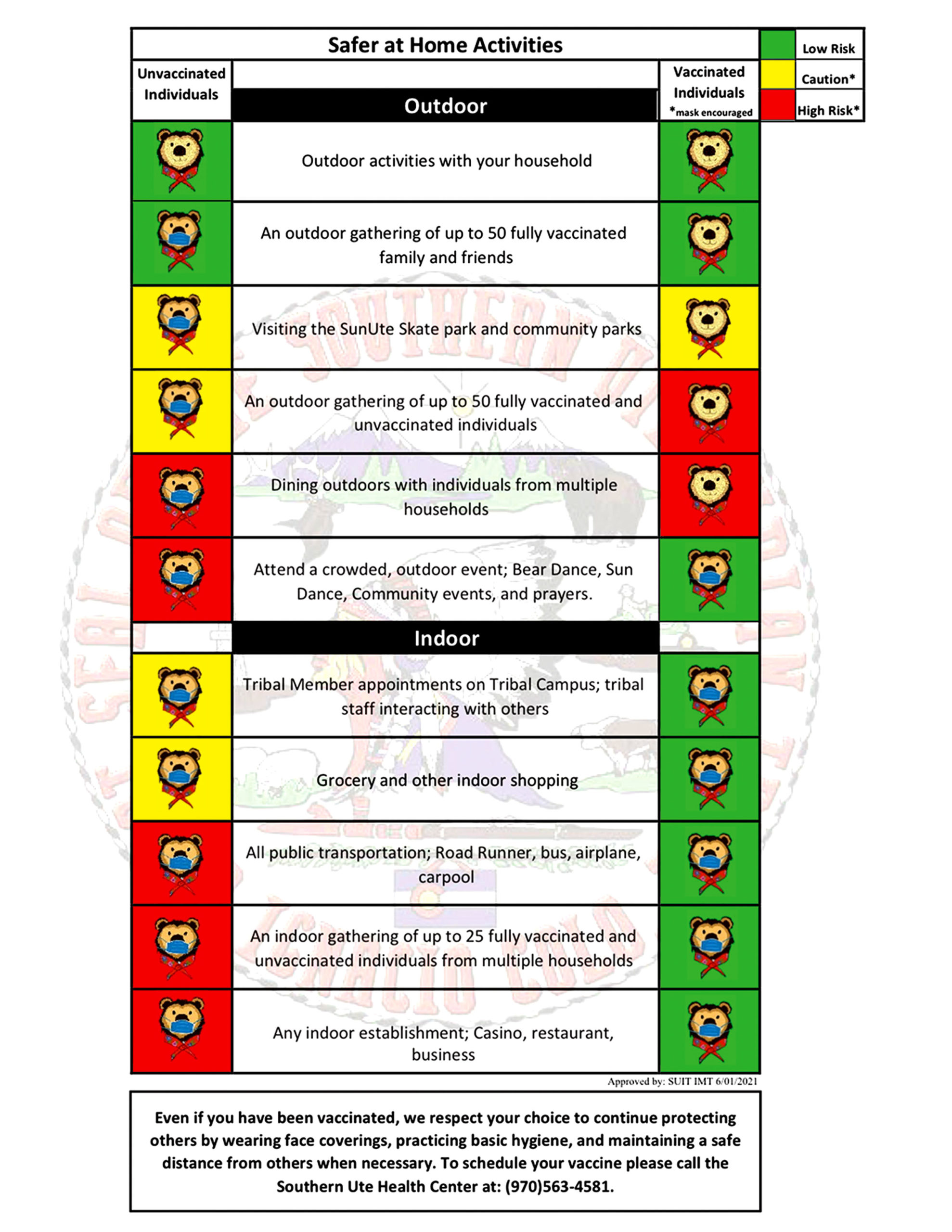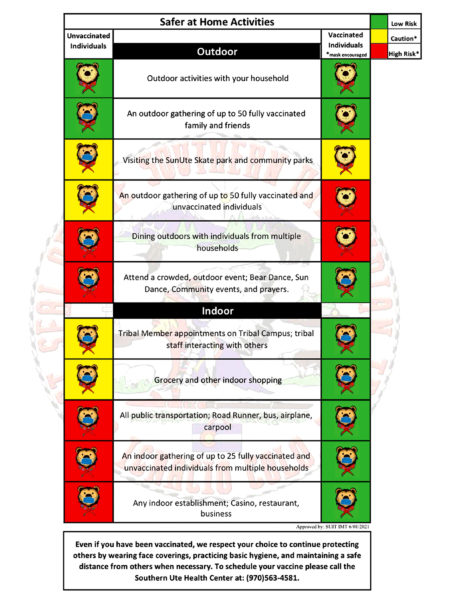PUBLIC HEALTH ORDER
WHEREAS, authority is vested in the Southern Ute Indian Tribal Council by the Constitution adopted by the Southern Ute Indian Tribe, and approved November 4, 1936, and amended October 1, 1975, and August 27, 1991, to act for the Southern Ute Indian Tribe; and
WHEREAS, under Article VII, Section 1 of the Constitution, “The inherent powers of the Southern Ute Indian Tribe, including those set forth in [the Indian Reorganization Act], as amended, shall be exercised by the Southern Ute Indian Tribal Council, subject only to limitations imposed by the Constitution and Statutes of the United States, by the regulations of the Department of the Interior and by this constitution.”; and
WHEREAS, under Article VII, Section l(e) of the Constitution, “The Tribal Council may enact ordinances and codes to protect the peace, safety, property, health and general welfare of the members of the Southern Ute Indian Tribe”; and
WHEREAS, under Article VII, Section 1(n) of the Constitution, Tribal Council has the authority, “To protect and preserve the property, wildlife and natural resources of the [T]ribe, and to regulate the conduct of trade and the use and disposition of tribal property upon the reservation.”; and
WHEREAS, in Res. No. 2004-225, the Tribe approved the Southern Ute Community Emergency Operations Plan (“Plan”), the purpose of which is to identify the emergency management process and principles for managing and coordinating the overall response and recovery activities during periods of emergency/disaster resulting from a natural-or human-caused hazard; and
WHEREAS, Section IV(B) of the Plan identifies Emergency Management operational phases, including the Response Phase, which may include incident mitigation activities designed to limit the loss of life, personal injury, property damage, and unfavorable outcomes; and
WHEREAS, pursuant to the Plan, Section IV(B)(3), response activities may include ongoing public health and testing processes, immunizations, isolation, or quarantine; and
WHEREAS, pursuant to the Plan, Section V(F), the Tribal Council’s duties in an emergency or disaster include, among other things, signing a resolution declaring an emergency or disaster to protect life and preserve property and the environment by ensuring prevention, preparation, and response measures are in place; and
WHEREAS, in January 2020, the World Health Organization designated the novel coronavirus (COVID-19) outbreak as a pandemic; and
WHEREAS, in Res. No. 2020-025, Tribal Council declared a state of emergency to respond to the spread of COVID-19; and
WHEREAS, in Res. No. 2020-031, Tribal Council approved the Southern Ute Health Center Communicable Disease Response Plan, which allows for, among other things, infection control precautions, including contact, droplet, and airborne precautions; and
WHEREAS, on March 25, 2020, Tribal Council issued a Stay at Home Order limiting visitation to the Reservation and restricting activities to only those activities that were deemed to be essential; and
WHEREAS, on July 17, 2020, Tribal Council issued a Public Health Order requiring face coverings indoors at all times and outdoors when other social distancing measures were not possible; and
WHEREAS, on March 29, 2021, as COVID-19 cases began to level off and a coronavirus vaccine became more readily available in and around the Southern Ute Indian Reservation, Tribal Council issued a Safer at Home Order, which superseded the Stay at Home Order and eased previously established restrictions; and
WHEREAS, the Centers for Disease Control and Prevention (“CDC”) recently eased recommendations for when face coverings should be worn; and
WHEREAS, the Tribal Council finds it in the interests of public health and safety to continue to require face coverings indoors unless a person is alone; and
WHEREAS, as the number of vaccinated people nationwide has grown and the risk of COVID-19 transmission has therefore decreased, and research shows that COVID-19 is less transmissible in well ventilated outdoor spaces when compared to indoor spaces, Tribal Council finds it is no longer necessary to require people to wear face coverings while outdoors.
NOW THEREFORE, TRIBAL COUNCIL HEREBY ORDERS:
- All individuals over two years old must wear a face covering over their nose and mouth when entering or moving within any public indoor space, unless the individual is alone in the room.
- Face covering means a covering made of cloth, fabric, or other soft or permeable material, without holes, that covers only the nose and mouth and surrounding areas of the lower face, and that fits snugly but comfortably against the side of the face and remains in place without the use of one’s hands. Face coverings include, but are not limited to, bandanas, medical masks, cloth masks, buffs, and gaiters. Businesses have the discretion to have more restrictive face covering protocols. Face coverings do not include any mask that incorporates a one-way valve (typically a raised plastic cylinder about the size of a quarter on the front or side of the mask) that is designed to facilitate easy exhaling, and such masks are not to be used tocomply with this Order. Valves of that type without filters permit droplet release from the mask and can put others nearby at risk.
- Public indoor space means any enclosed indoor area that is public or privately owned, managed, or operated to which individuals have access by right or by invitation, expressed or implied, and that is accessible to the public, serves as a place of employment, or is an entity providing services. Public indoor space does not mean a person’s residence, including a room in a motel or hotel.
- No owner, operator, or manager of a public indoor space may provide services to individuals or allow an individual to enter or move within that public indoor space, unless the individual is wearing a face covering as required by this Public Health Order.
- Owners, operators, or managers of public indoor spaces must post signs at entrance(s) instructing individuals of their legal obligation under this Order to wear a face covering when entering or moving within a public indoor space.
- Individuals two years old and younger are exempt from the requirements of this Order. Individuals ages three years old to nine years old are exempt from the requirements of this Order if they cannot medically tolerate a face covering.
- Individuals performing the following activities are exempt from the requirements of this Order while the activity is being performed:
-
- Individuals who are hearing impaired or otherwise disabled or who are communicating with someone who is hearing impaired or otherwise disabled and where the ability to see the mouth is essential to communication;
- Individuals who are seated at a food service establishment;
- Individuals who are exercising alone or with others from the individual’s household when a face covering would interfere with the activity;
- Individuals who are receiving a personal service where the temporary removal of the face covering is necessary to perform the service;
- Individuals who enter a business or receive services and are asked to temporarily remove a face covering for identification purposes;
- Individuals who are actively engaged in a public safety role such as law enforcement, firefighters, or emergency medical personnel;
- Individuals who are officiating at a religious service; or
- Individuals who are giving a speech for broadcast or an audience.
8.This order supersedes the Public Health Order regarding face coverings that was issued on July 17, 2020.
BE IT FURTHER RESOLVED, that this Order shall become effective at 12:01 a.m. on June 2, 2021 and will continue until it is no longer necessary as deemed by the Southern Ute Indian Tribal Council.
SOUTHERN UTE INDIAN TRIBE
Date: 6-1-21
By: Melvin J. Baker





